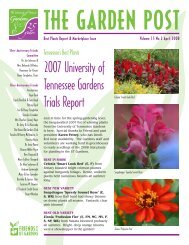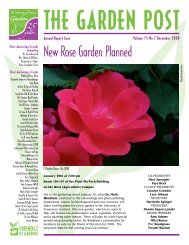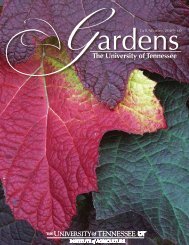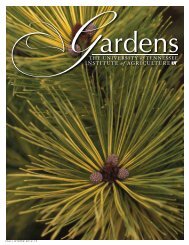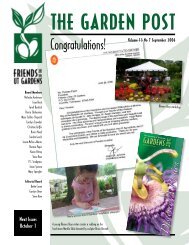October - UT Gardens - The University of Tennessee
October - UT Gardens - The University of Tennessee
October - UT Gardens - The University of Tennessee
You also want an ePaper? Increase the reach of your titles
YUMPU automatically turns print PDFs into web optimized ePapers that Google loves.
From the <strong>UT</strong> <strong>Gardens</strong> Curator<br />
Good News<br />
James Newburn<br />
Now that the temperatures are cooling and there’s a<br />
fall nip in the air, the <strong>UT</strong> <strong>Gardens</strong> again come alive<br />
with color. Against the brilliant blue autumn sky,<br />
nature’s rainbow <strong>of</strong> color gives us one last show.<br />
In the perennial border the asters are the royal<br />
ladies donning the purple. Whether it is the delicately<br />
flowered light purple <strong>of</strong> the sturdy stemmed<br />
Tatarian Aster, Aster tataricus, that reaches up to<br />
five to six feet tall, or the deeper hued and more<br />
low-growing New England Asters, A. novae-angliae,<br />
these richly colored late bloomers are a must<br />
have for any fall landscape. Also in the perennial<br />
border White Doll’s Daisy or False Aster, Boltonia<br />
asteroides ‘Snowbank,’ is a mass <strong>of</strong> snowy white<br />
blooms about four feet tall while Solidago rugosa<br />
‘Fireworks’ is an explosion <strong>of</strong> golden-yellow goldenrod<br />
about the same manageable size.<br />
Throughout the <strong>Gardens</strong> you will notice our collection<br />
<strong>of</strong> Japanese maples brightly displaying their<br />
fall colors <strong>of</strong> gold, yellow and red. My particular<br />
favorite is Acer palmatum ‘Sango-kaku,’ or Coral<br />
Bark Japanese Maple, which is aptly named for its<br />
rich coral to red stem color. In many areas we have<br />
paired these with choice conifers—for instance, a<br />
blue spruce, Picea pungens, and Deodar cedar,<br />
Cedrus deodara, in the lowest garden room next<br />
to Neyland Drive, where the blue and grey-green<br />
needles <strong>of</strong> the conifers showcase even more the<br />
beauty <strong>of</strong> the maple’s bark and foliage. You might<br />
try this combination in your garden.<br />
Finally, in the herb garden you cannot miss the brilliant<br />
yellow <strong>of</strong> the asparagus with its mass <strong>of</strong> finely<br />
textured delicate foliage that is about four to five<br />
feet high. Swamp sunflower, Helianthus angustifolius,<br />
is probably one <strong>of</strong> the plants we get the most<br />
questions about in the fall because <strong>of</strong> its prolific<br />
blooming. Keep an eye out as well for the Tree<br />
Dahlia, also with a very appropriate botanical name:<br />
Dahlia imperialis. This majestic plant can reach<br />
10-12’ tall here and only blooms if we don’t get<br />
an early frost. If it is not nipped, its beautiful light<br />
purple blooms droop high overhead and provide<br />
one last spectacular flower display before winter<br />
sets in.<br />
I think fall is the best time <strong>of</strong> year, though, to focus<br />
on the garden as a whole. Take the time either<br />
here or in your own garden to step back and look<br />
at the panoramic landscape. Enjoy the view that a<br />
well blended garden <strong>of</strong> a variety <strong>of</strong> colors, textures,<br />
heights, and forms provide when an effective<br />
combination <strong>of</strong> deciduous trees, conifers, shrubs,<br />
annuals, grasses, and herbs are utilized.<br />
Well blended fall garden. clockwise from top center: Nuttall Oak, Eucalyptus,<br />
Artemisia ‘Powis Castle’, Asparagus, European Hornbeam.<br />
Membership in the Friends stands at nearly 800 in<br />
late 2007, an increase <strong>of</strong> nearly 500 members from<br />
late 2004.<br />
<strong>The</strong> numbers <strong>of</strong> members supporting at much<br />
higher levels has also increased substantially. In<br />
late 2004, the Friends had no Benefactors and<br />
no Patrons, four Sponsoring Friends, 17 Business<br />
Friends, 10 Garden Clubs/Societies, and 26<br />
Contributing Friends beyond the entry levels <strong>of</strong><br />
Family and Individual memberships.<br />
News Briefs<br />
Officers and new board members will be elected at<br />
a brief business meeting before the lecture at the<br />
Annual Membership Meeting Nov. 5. A postcard<br />
will be mailed to all Friends two weeks before the<br />
meeting with slate and reminder re the meeting.<br />
<strong>Gardens</strong> director Dr. Susan Hamilton reports that<br />
500 more <strong>of</strong> the trees and shrubs in the <strong>Gardens</strong>’<br />
collection now are marked with new rodent-resistant<br />
anodized aluminum labels, bringing to more than<br />
1,000 the number <strong>of</strong> trees and shrubs with permanent<br />
botanical labels. <strong>The</strong> <strong>UT</strong> Experiment Station<br />
has financed these new labels to enhance the<br />
appearance and interpretation <strong>of</strong> the tree and shrub<br />
plant collection. Friends co-president Faye Beck,<br />
graduate teaching assistant Andy Pulte, and undergraduate<br />
Tony Clark worked with Dr. Hamilton on<br />
correct plant nomenclature for the labels.<br />
In August, the Friends board made a donation<br />
to Camp Hart Scholarship in memory <strong>of</strong> Willie<br />
Hart, whose company Ritchie Tractors has been a<br />
supporter <strong>of</strong> Blooms Days for many years. Mr. Hart’s<br />
son, Dr. Willie Hart, is on the faculty at <strong>UT</strong> and has<br />
also been <strong>of</strong> great assistance at Blooms Days every<br />
year. Friends who would like to add their individual<br />
contributions can do so by sending memorials to<br />
By 2007, we have 10 Silver Anniversary Friends,<br />
seven Benefactors, six Patrons, six Business Patrons,<br />
one Business Sponsor, 27 Business Friends, 24<br />
Sponsoring Friends, 15 Garden Clubs/Societies,<br />
seven Student Friends and 124 Contributing Friends.<br />
Thanks to all <strong>of</strong> you! You have made it possible<br />
for the Friends to do much more in a much more<br />
pr<strong>of</strong>essional manner to grow the Friends and<br />
convert our support for the <strong>Gardens</strong> to a more<br />
sustainable enterprise.<br />
Galeux d’Eysines Squash<br />
the Washington County Extension Office, 206 W.<br />
Main Street, Jonesborough, Tenn. 37659-1320.<br />
Recently seen at a farmer’s stand at the Knoxville<br />
Market Square: Galeux d’Eysines Squash just in<br />
time for Fall celebrations. This “creepy crawler”<br />
giant squash (C. maxima) was first seen at the<br />
Pumpkin Fair in Tranzault, France, in 1996 from<br />
seed collected by Amy Goldman from La Ferme de<br />
Ste. Marthe, Cour-Cheverny, France. Sweet, moist,<br />
orange flesh, great for baking and in soups. Fruits<br />
weigh 10-20 pounds and should be harvested<br />
before overly mature (90 days) because the peanutlike<br />
warts continue to grow and will cover the entire<br />
fruit. Beautiful enough for table centerpieces.<br />
Creepy enough for Halloween. Rightfully called<br />
“bumpkins” by clever children. A sure seller for farm<br />
and market stands.<br />
Photo by Allison Roberts<br />
6 7



